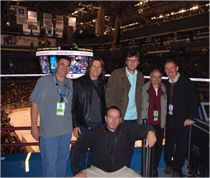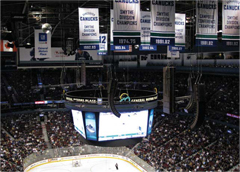Vancouver’s GM Place Puts Sound On Ice
VANCOUVER, BC, CANADA—In 2007, the new owners of General Motors Place, Canucks Sports and Entertainment, asked consultant John Riley to take a look at the audio and other systems in the 18,000-seat venue. Riley, who became chief audio technician for Canucks Sports and Entertainment in early 2008, found that there was more wrong with the infrastructure than imagined. The time had come for a new system, for NHL Canucks hockey fans, concert-goers, and for the upcoming 2010 Winter Olympics. GM Place, which temporarily will be renamed Canada Hockey Place for the Games, will be the main venue for hockey competitions.
The L-Acoustics speaker system features line-source arrays consisting of 78 dV-DOSC speakers, 12 dV-SUBs, 16 SB28 subs, 24 LA8 DSP amps, and six ARCS speakers. is similar to ours so I went there to hear the LAcoustics system. I hadn’t heard the dV-DOSC version before but I knew it was designed to do what I wanted.”
The physics of the L-Acoustics system was particularly appealing, he said. “Nobody else does a line source array—it creates a single point source that reduces phase cancellation and other interference. Audio is subjective; if you can work with the physics of audio then the rest is not black magic.”
The L-Acoustics speaker system, designed by Vaino Gennaro, director of live sound products, Sennheiser Canada, features line-source arrays consisting of 78 dV-DOSC speakers, 12 dV-SUBs, 16 SB28 subs, 24 LA8 DSP amps, and six ARCS speakers. Other components include an Optocore distributed audio and control system, Soundcraft Vi6 mixing console/ digital control surface, multinode Riedel Artist digital matrix intercom system, and Lectrosonics digital hybrid wireless microphone/IFB system.
Riley wanted the Vi6 for its flexibility. “I can change it to a 96-input console,” he said. “It talks to the Optocore via MADI; there’s no analog wiring except in interfacing with analog equipment. I can plug the local rack into network and run it all from my home computer though I wouldn’t know the exact volume.”
To maintain project control, Riley brought in RMPS for installation. “We needed a turnkey system, one company to supply and install,” he said. “Fred has access to all the technologies, brands, and manpower as well as an experienced team of installers and project managers.”

The General Motors Place crew. tied in, a whole new fiber optic system, and new intercom easily should have taken a year. But the idea was to hit the first exhibition game on September 21.”
RMPS had the month of August before entering the building, he said. “John had the vision and I followed his lead, but sewing it all together and making sure it functioned was up to us. We made the game deadline and that was huge and satisfying.
“Audience expectation is much higher now, so when fans go to sports events they want great audio,” Michael added. “The main issue here was fidelity and consistency of coverage. There was very little ice coverage in the bowl’s old system. We put four L-Acoustics ARCS speakers in as a separate ice coverage system, installed in the middle of the scoreboard. There’s a separate setting in the DSP so when you go to that setting all the arrays covering the bowl are timealigned and it all melds together. It’s great fun to go down there.”
The new system also is being used for concerts, but “the real stamp on the job, he notes, “is that the Canadian Olympic Committee will use the system for Olympic hockey events at the 2010 Games.”










